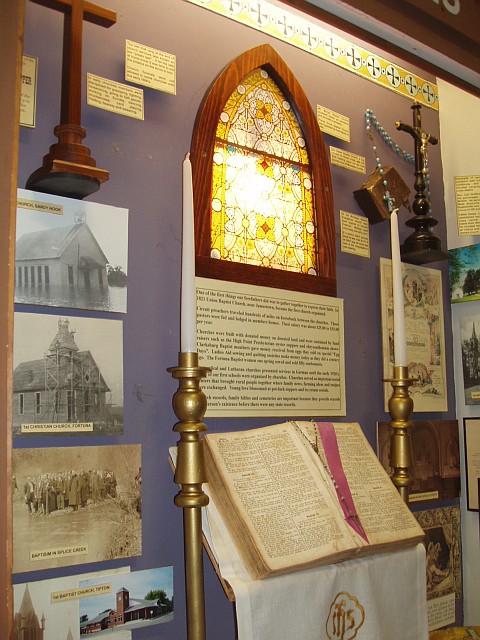By RICHARD SCHROEDER
Museum Chairman
The churches exhibit illustrates the history of some of the more than 40 churches in Moniteau County. One of the first things our forefathers did was to gather together to express their faith. In 1821 Union Baptist Church, near Jamestown, became the first church organized in the area that was to become Moniteau County. When Moniteau County was organized the first county officers met at Old Salem Church near Brush Creek. Circuit preachers and priests traveled hundreds of miles on horseback between churches. The pastors were fed and lodged in members' homes. Their salary was about $25 to $35 a year. In 1838 the pioneer Catholic priest Father Helias organized the Church of the Assumption at the tiny village of Cedron. He conducted mass there three or four times a year. The 175 year old church has been lovingly restored and is used for special events.
Churches were built with donated money on donated land and were sustained by church fundraisers such as the High Point Presbyterian Oyster Suppers and Chrysanthemum Shows. Clarksburg Baptist members gave money received from eggs they sold on special "Egg Day." Ladies Aid groups and sewing and quilting societies make monies today as they did a century ago. The Fortuna Baptist Women one spring sewed and sold 50 sunbonnets. The men of Moniteau Advent Church were required to furnish firewood. Widows needed to supply only one-half a cord. If a member failed he was fined $1 and his name was read at the next congregational meeting. This church also had a "potato bell" that was rung when church services were over to let households know to begin cooking the dinner.
Mt. Moriah Baptist accepted slaves as members and provided a cemetery for them. Blacks also attended Ebenezer Baptist Church in California until the congregation faded away or attended other local churches. There were no funerals held in churches until early 1900's and cemeteries had two gates; one for the corpse and the other for the mourners. Some churches had separate doors and pews for men and women. Early churches had rules that must be followed. Members were punished for gossiping, fighting, horseracing, going to ball games, working on Sundays, dancing, drunkenness, card playing, fiddling, heresy and swearing.
Evangelical and Lutheran churches presented services in German until the early 1940's. These services ceased when the war with Germany began. Some of our first schools were organized by churches. Churches served as important social centers that brought rural people together where family news, farming ideas and recipes were exchanged. Young love blossomed at pot-luck dinners and ice cream socials.
Church records, family Bibles and cemeteries are important because they provide records of a person's existence before there were state records. Today these records are still used in genealogical research.

